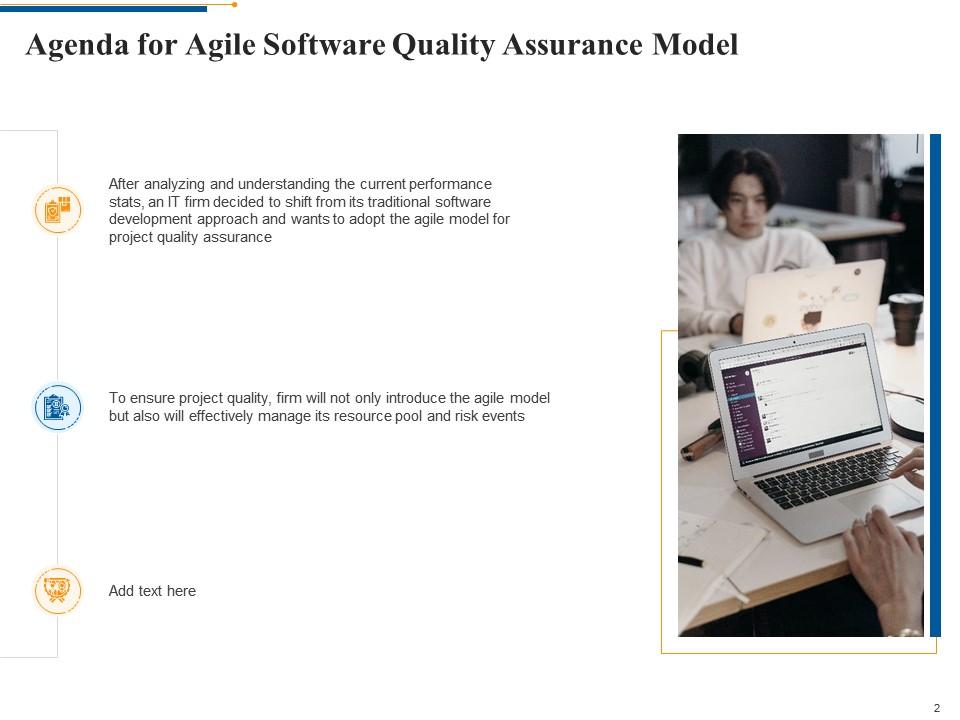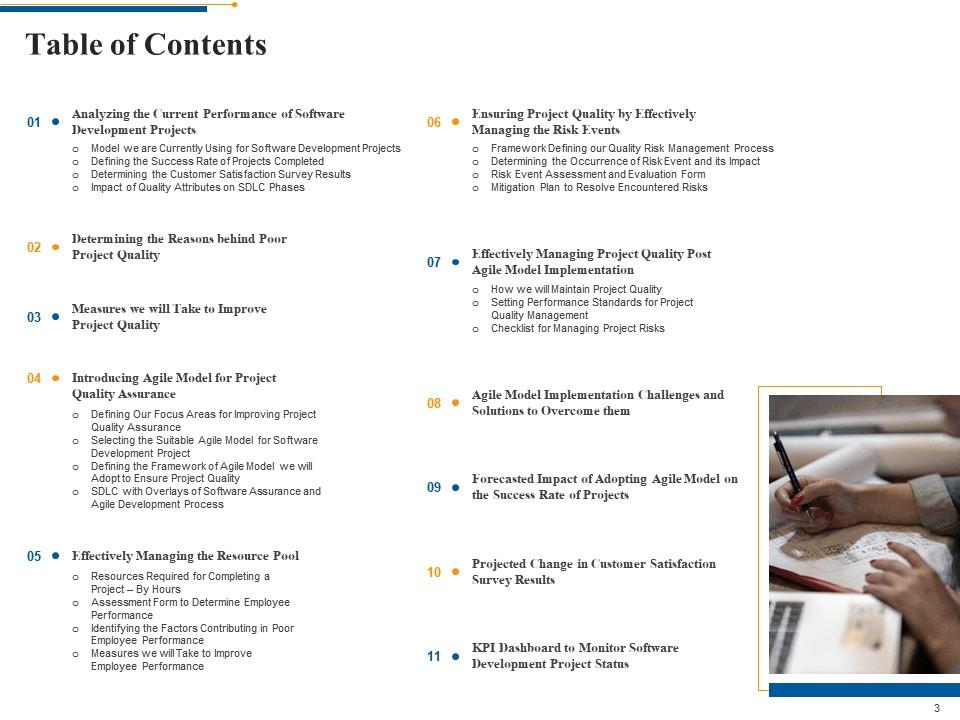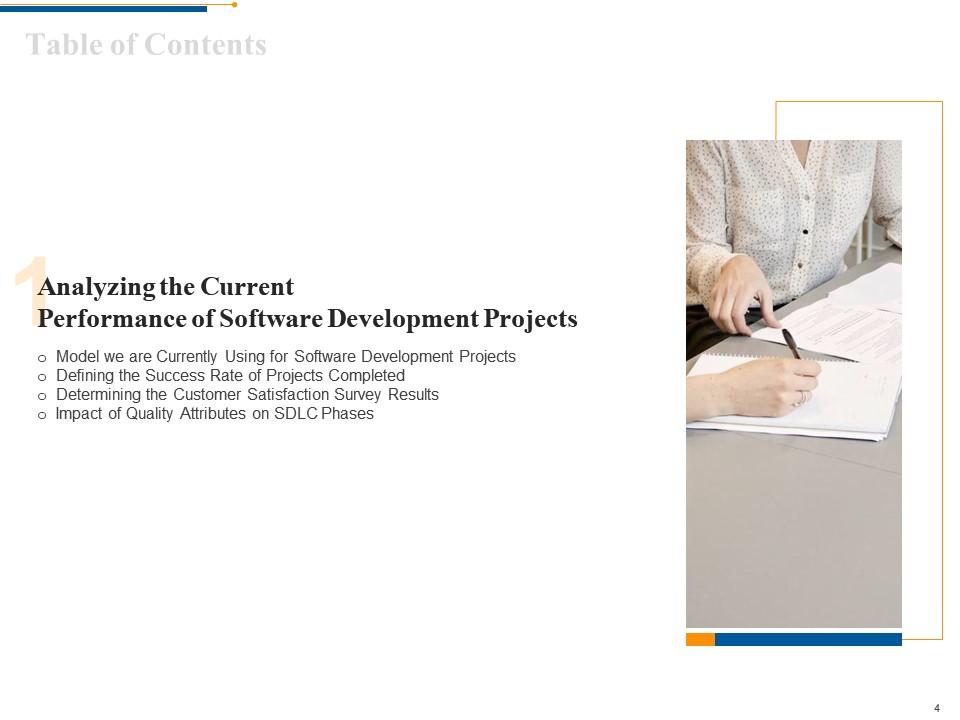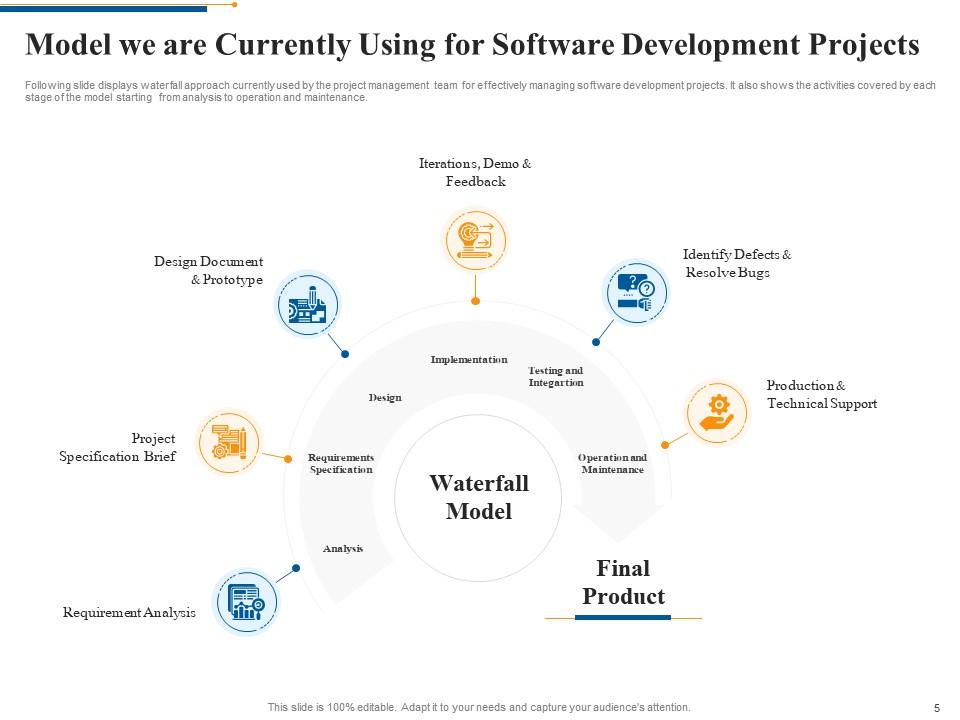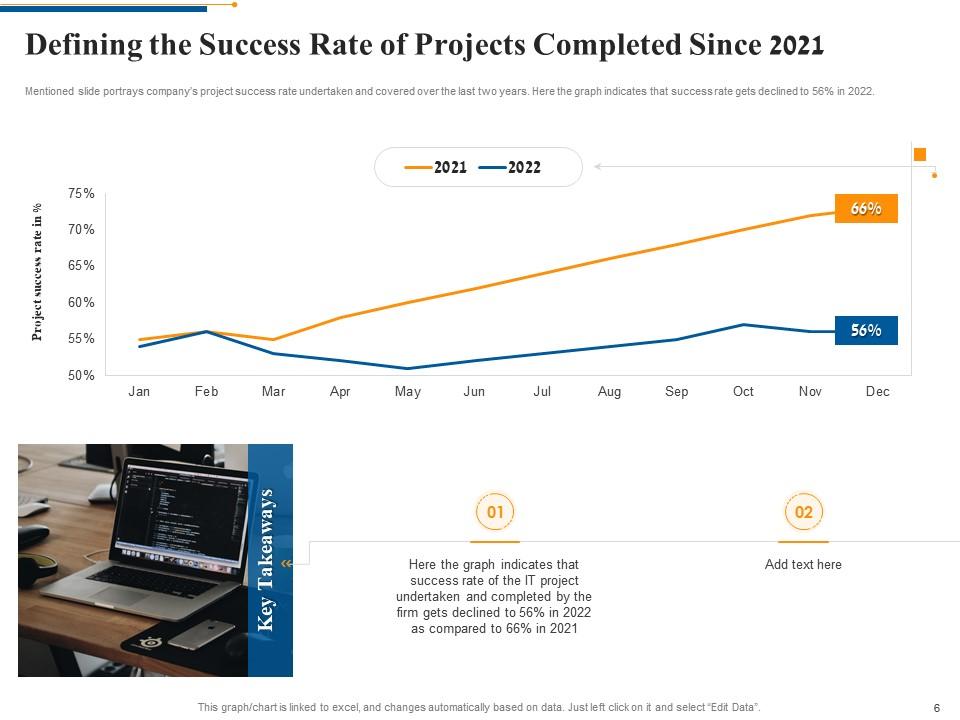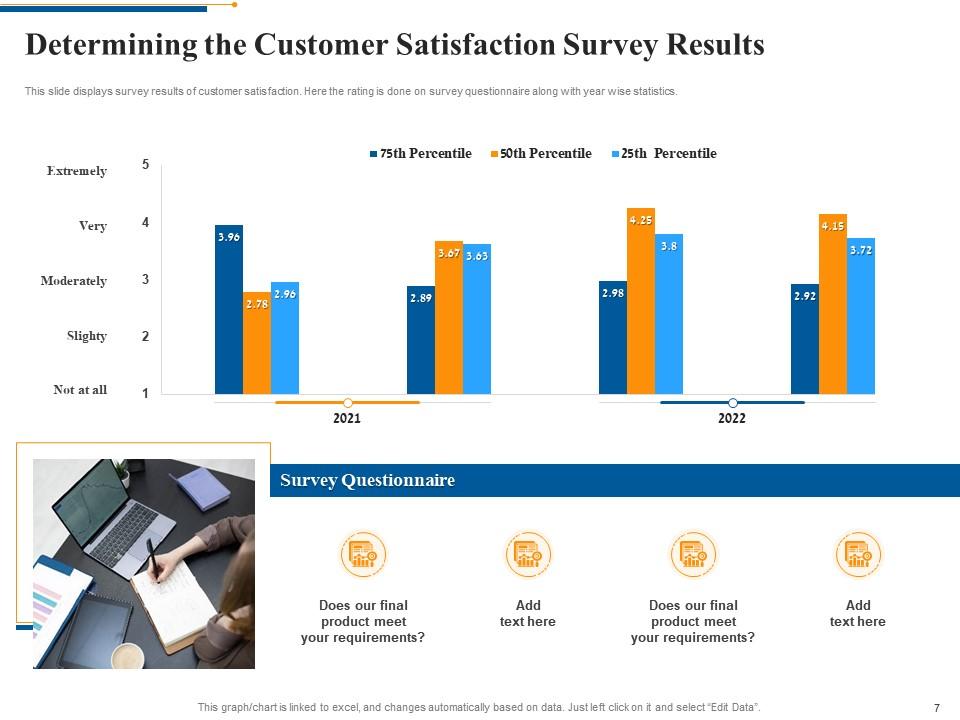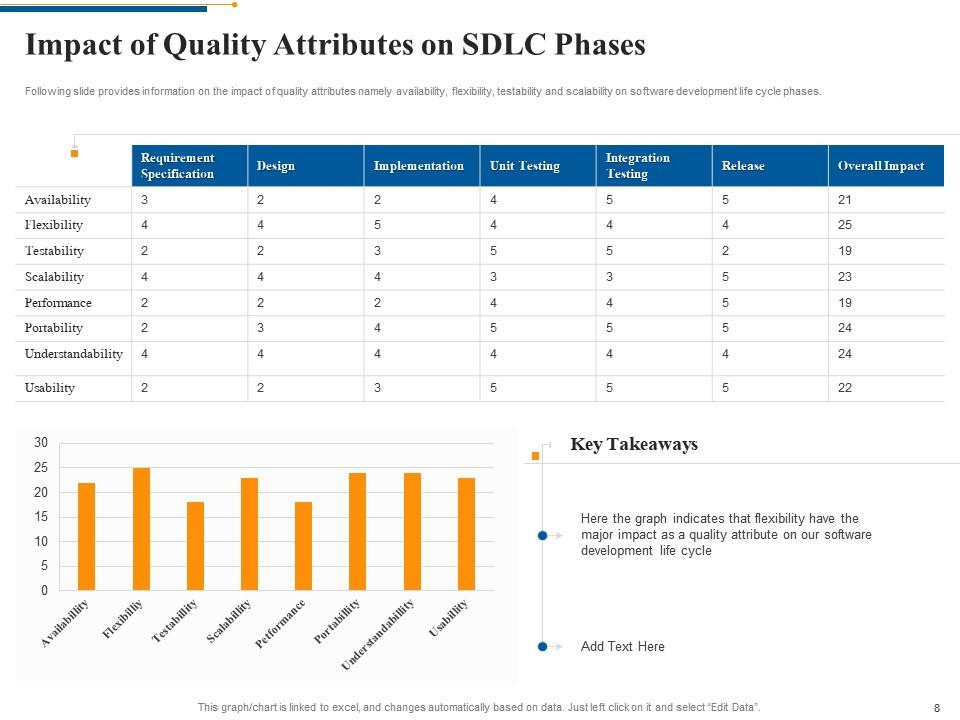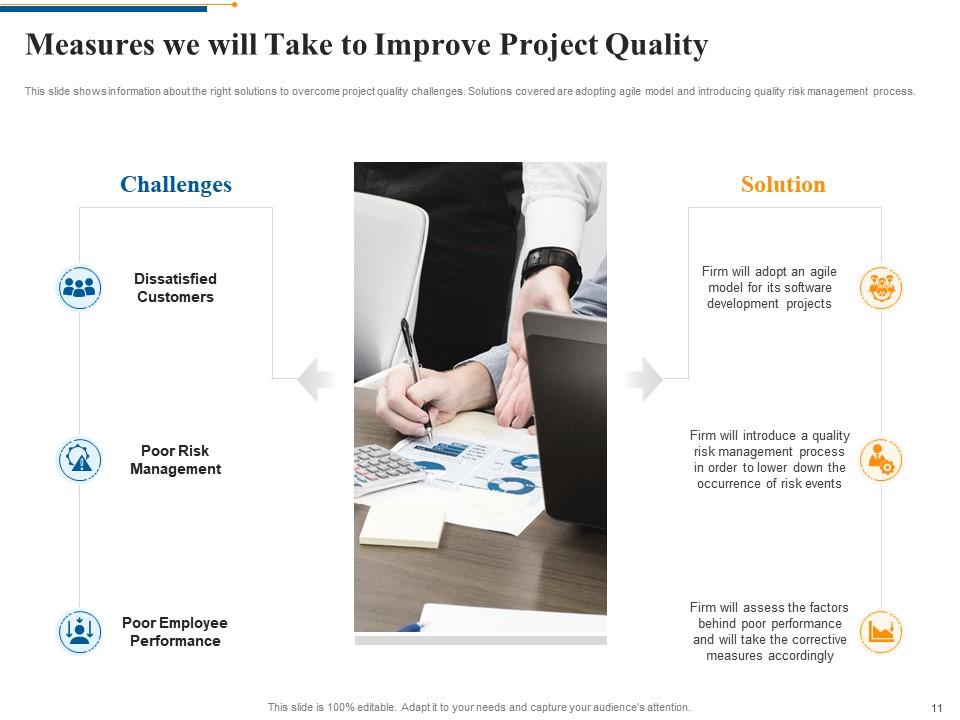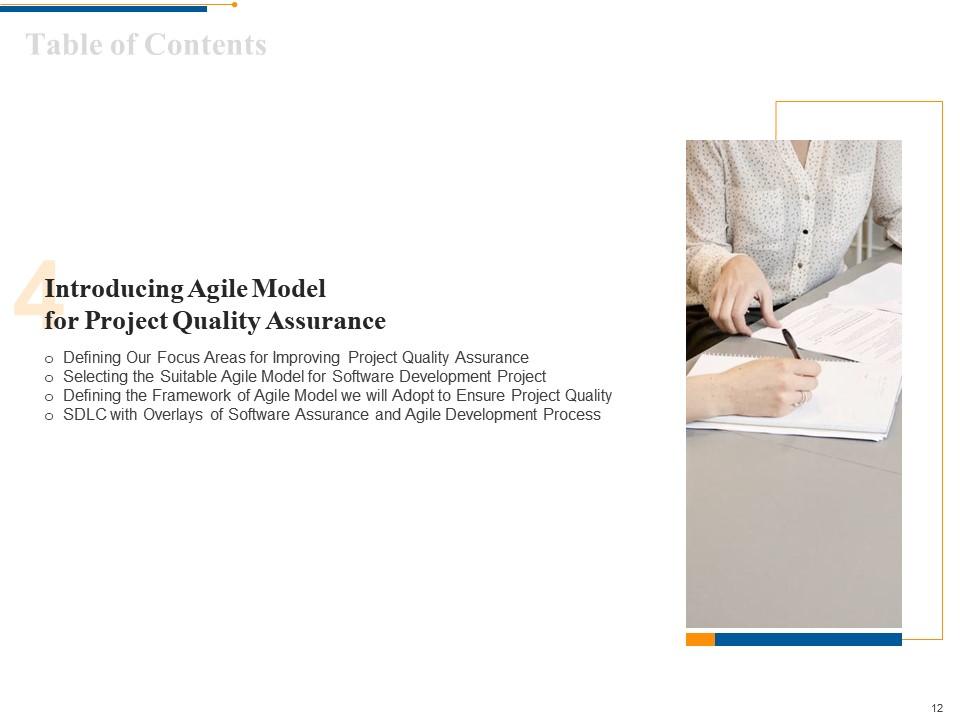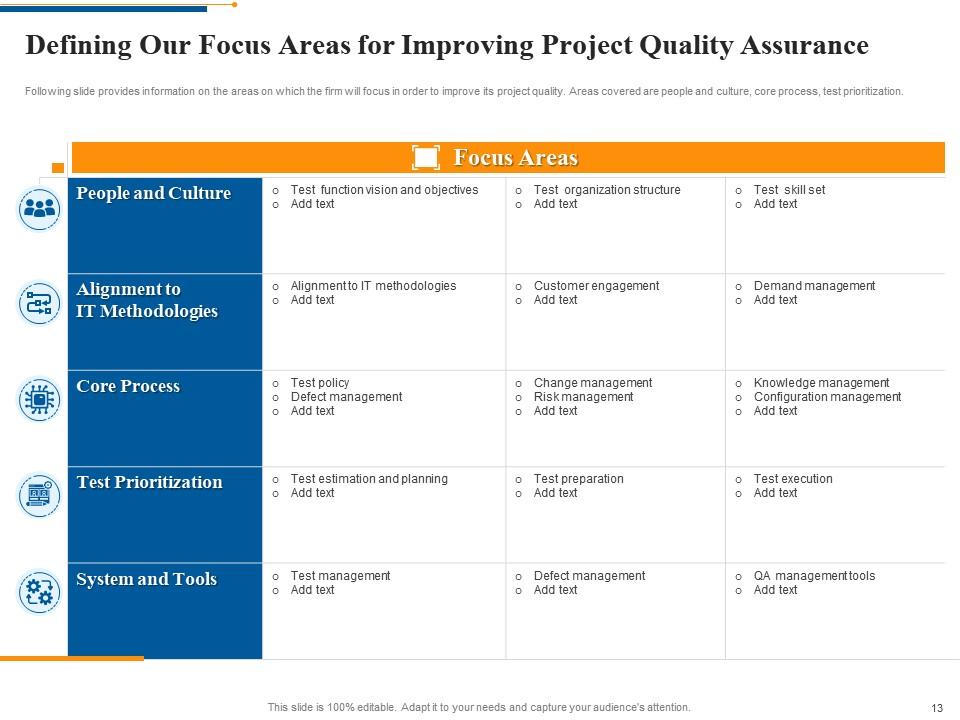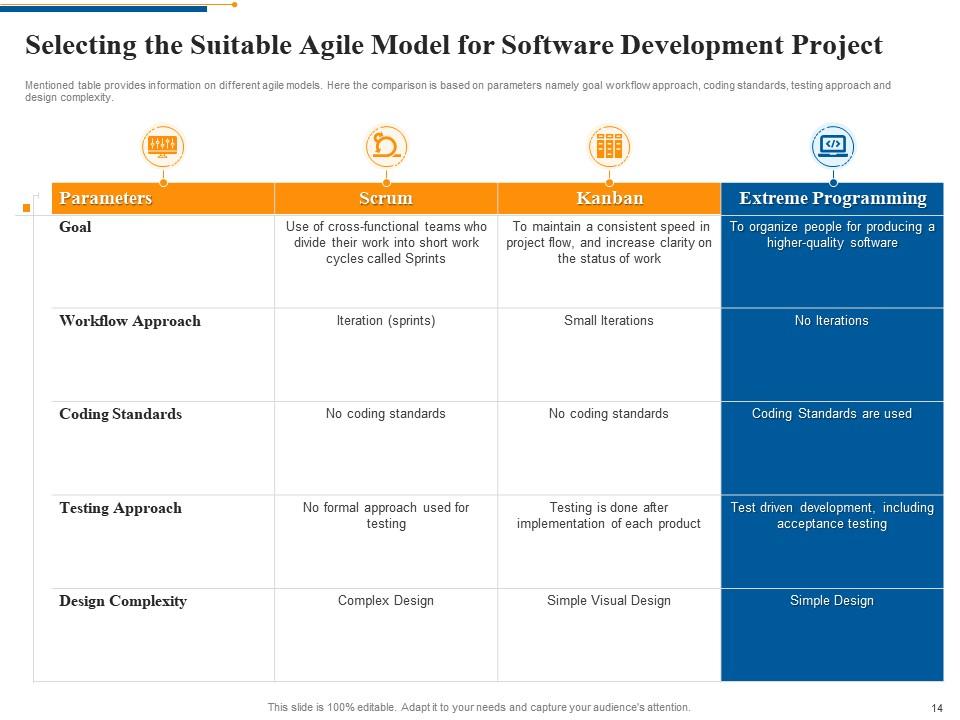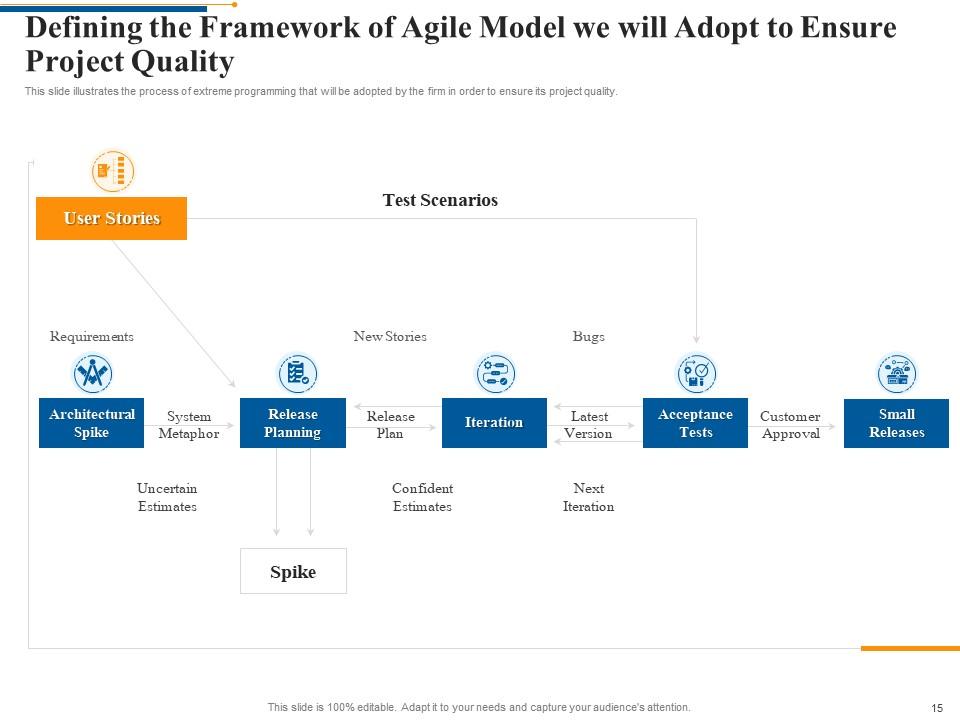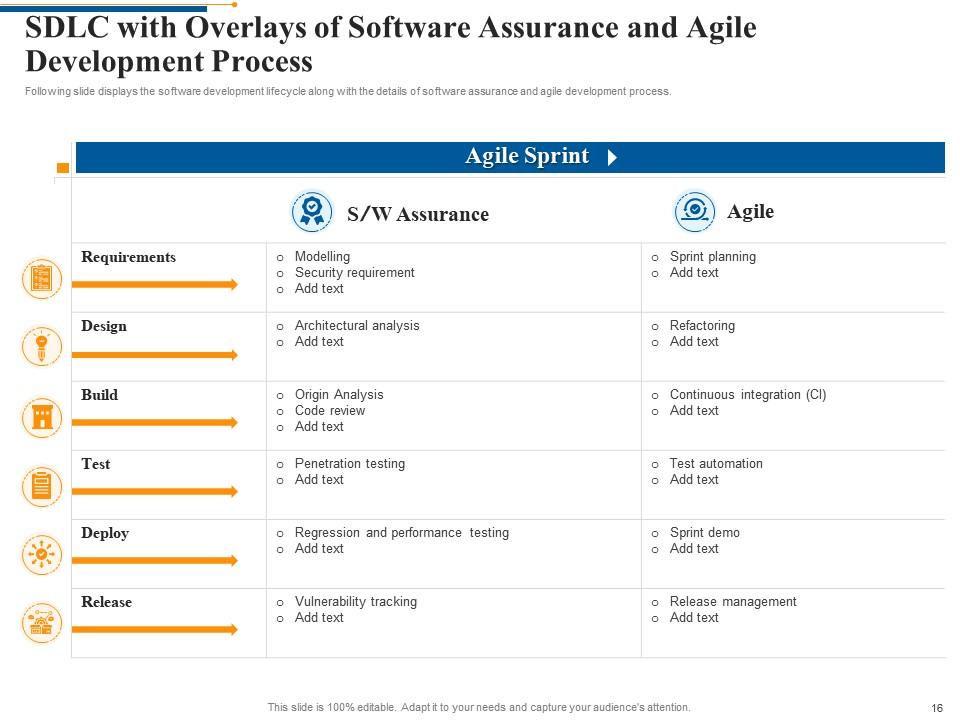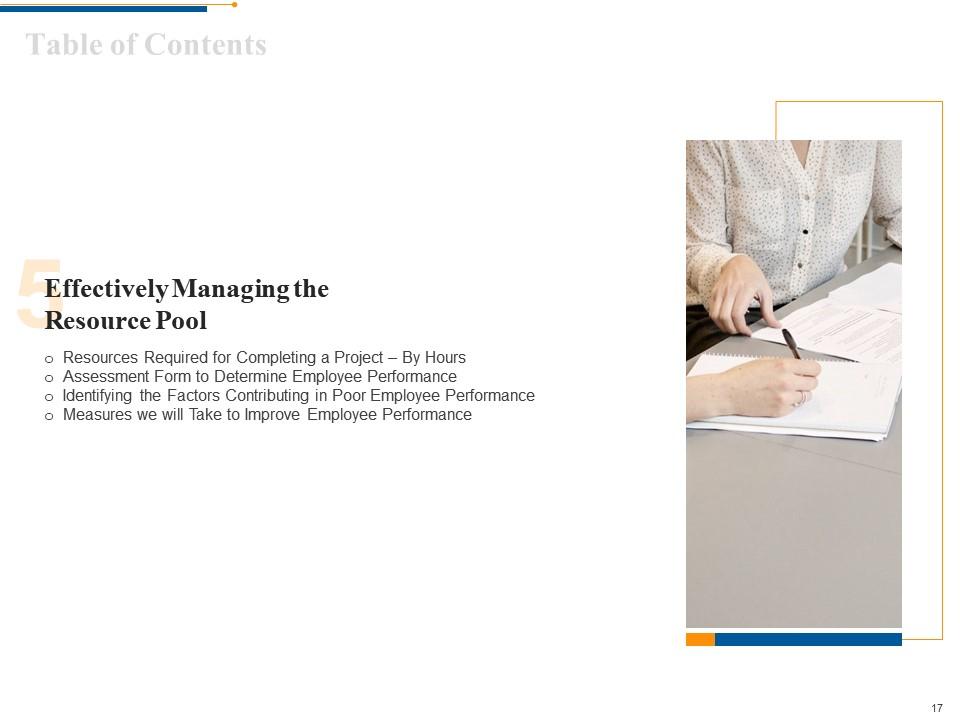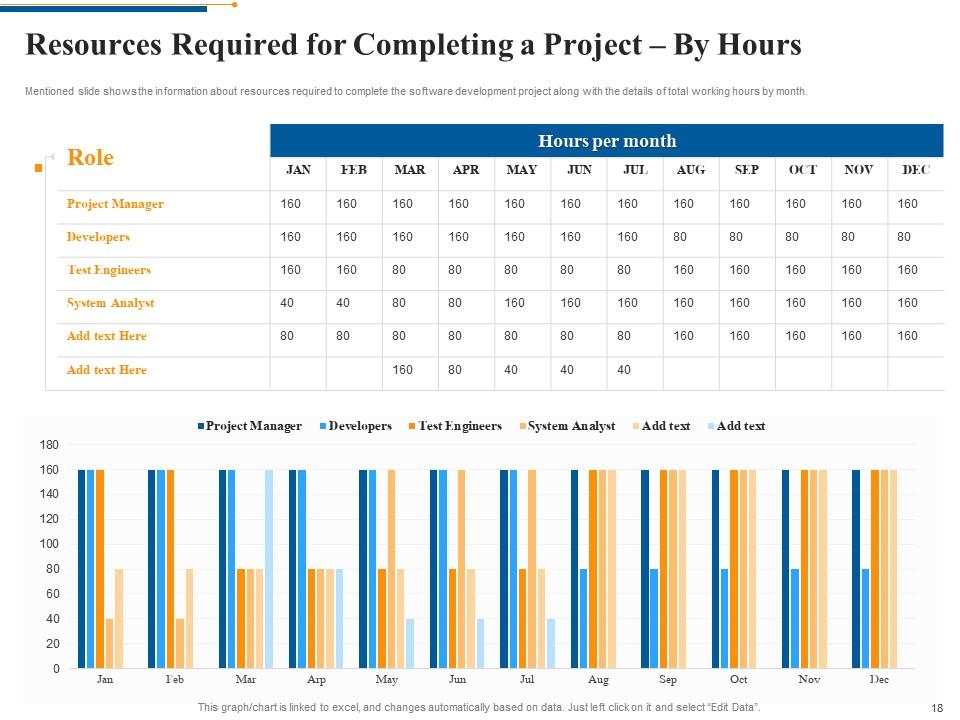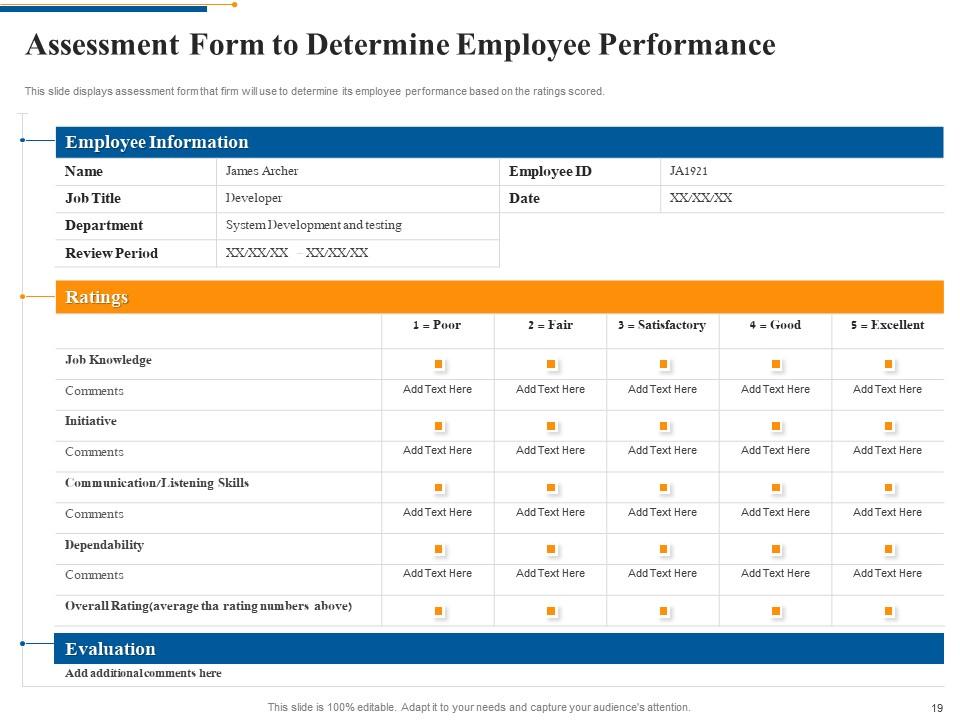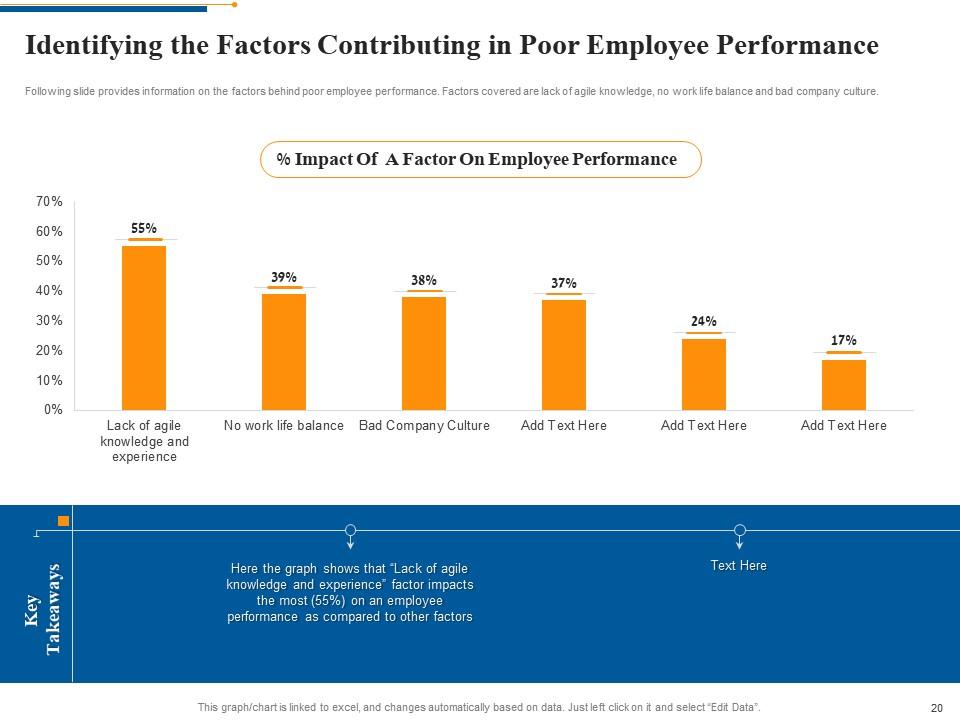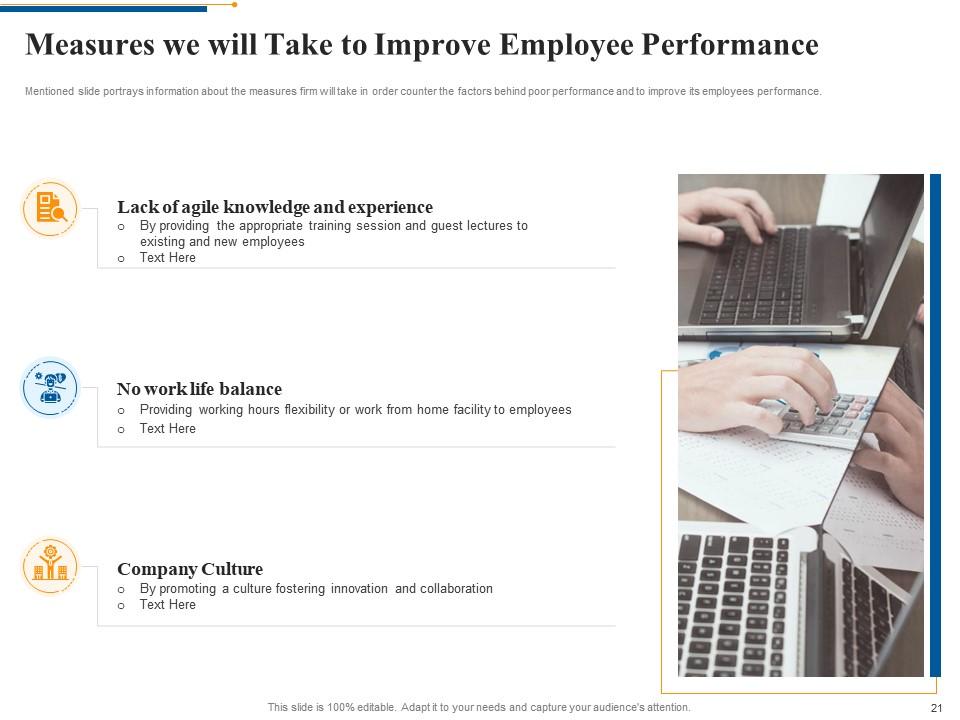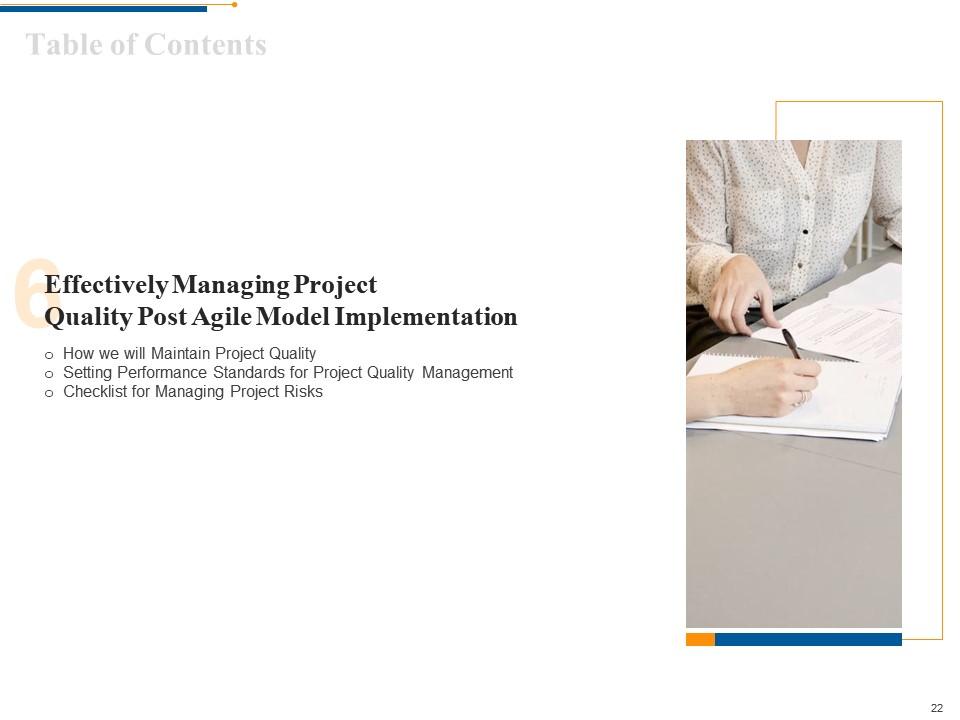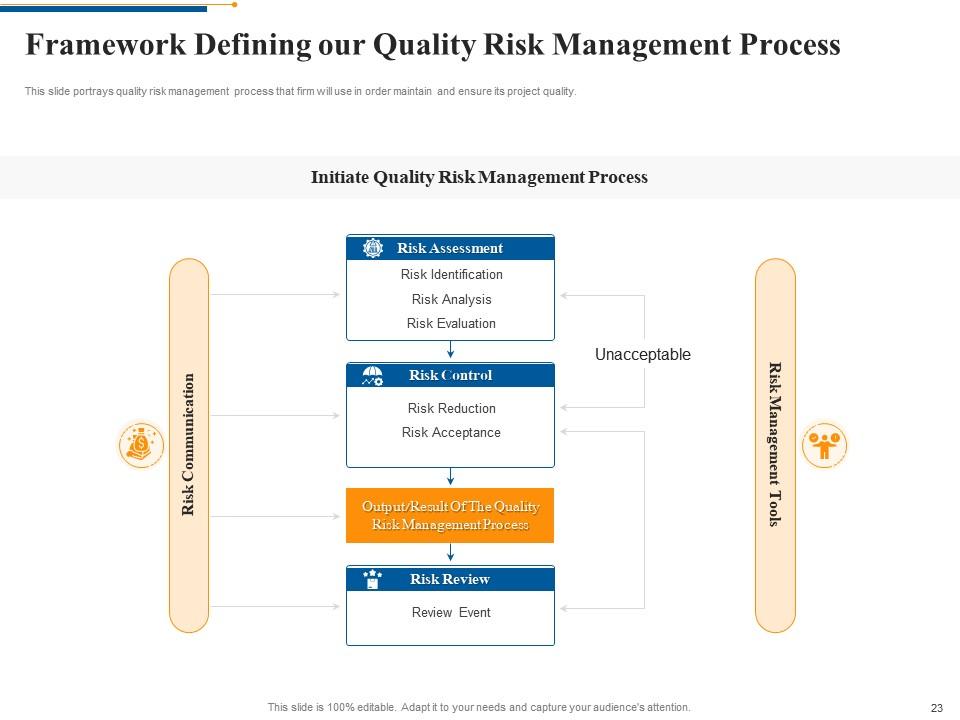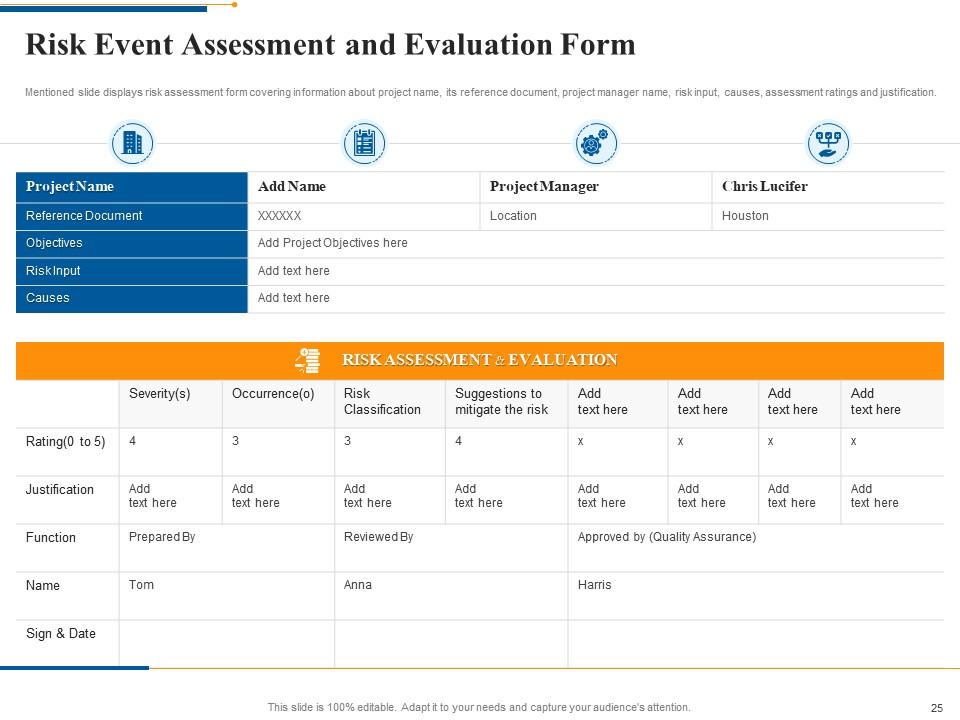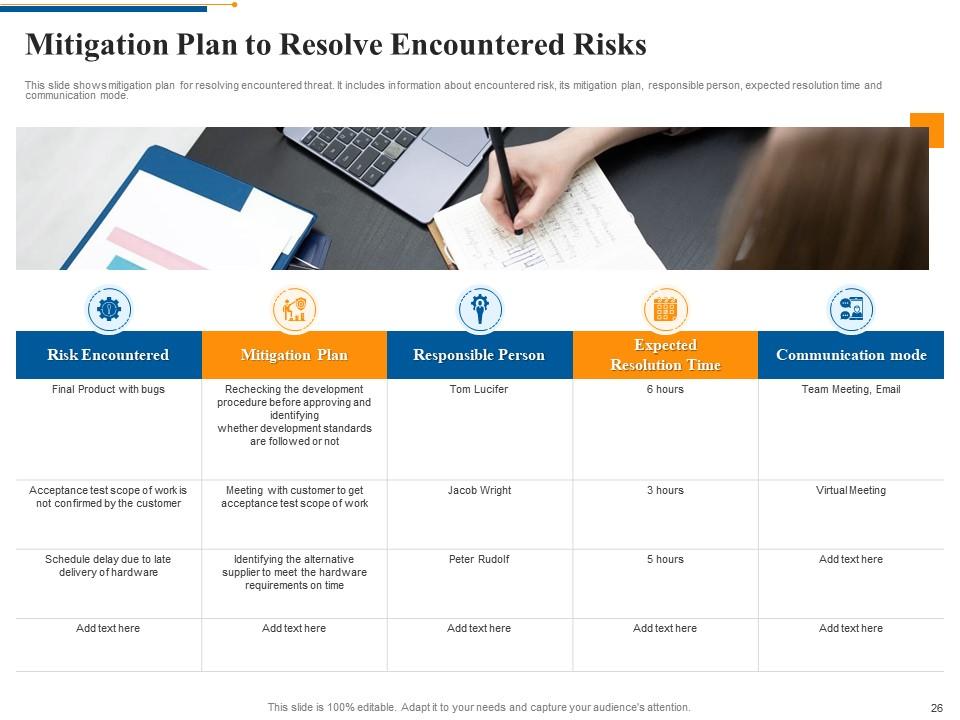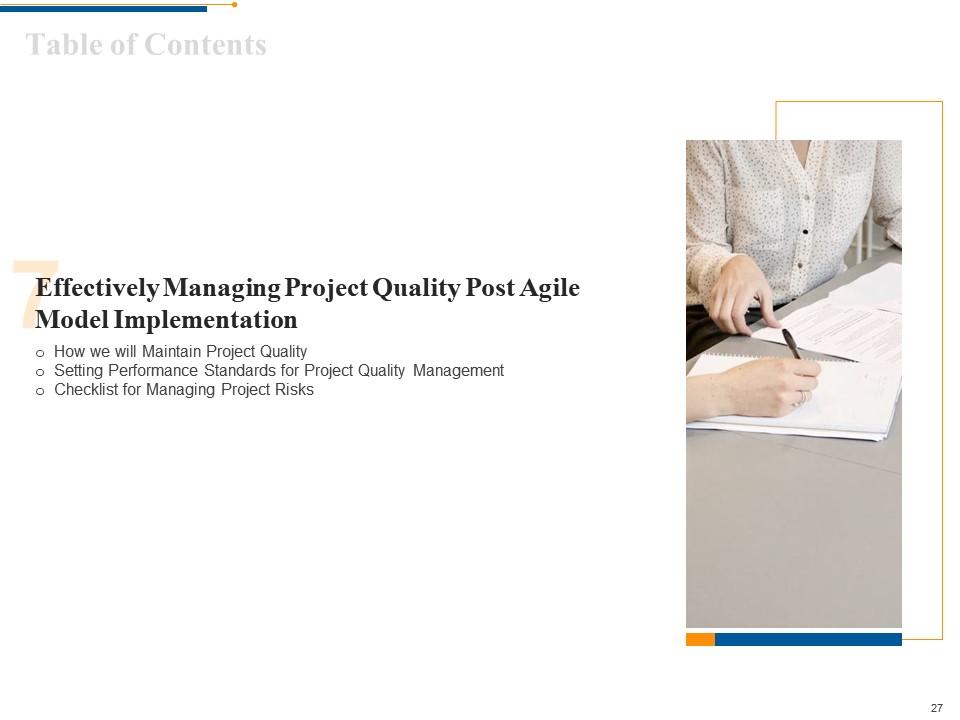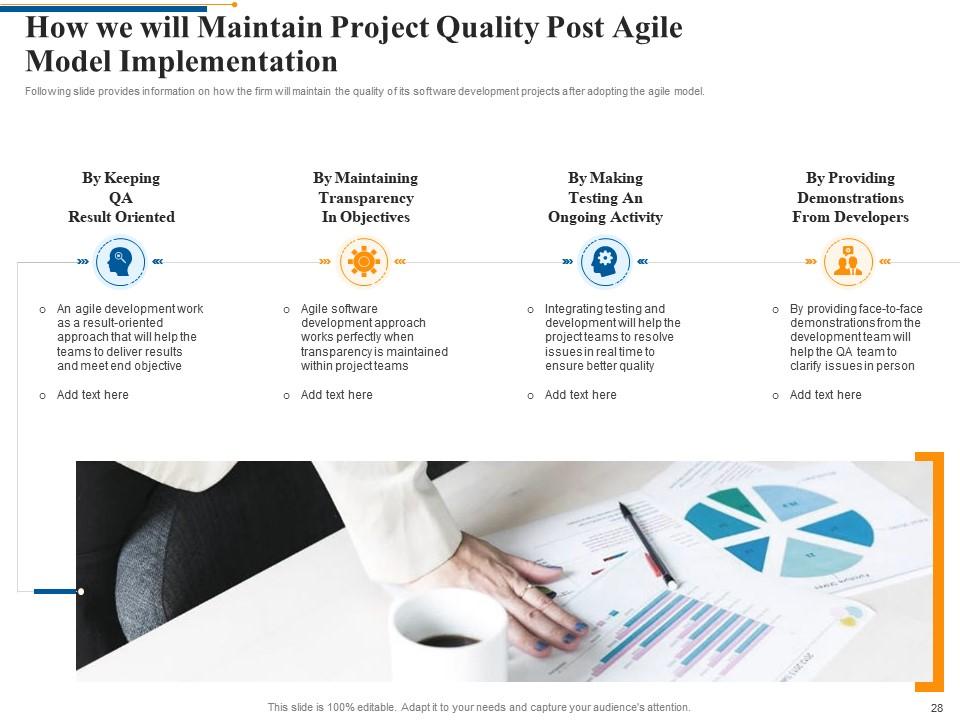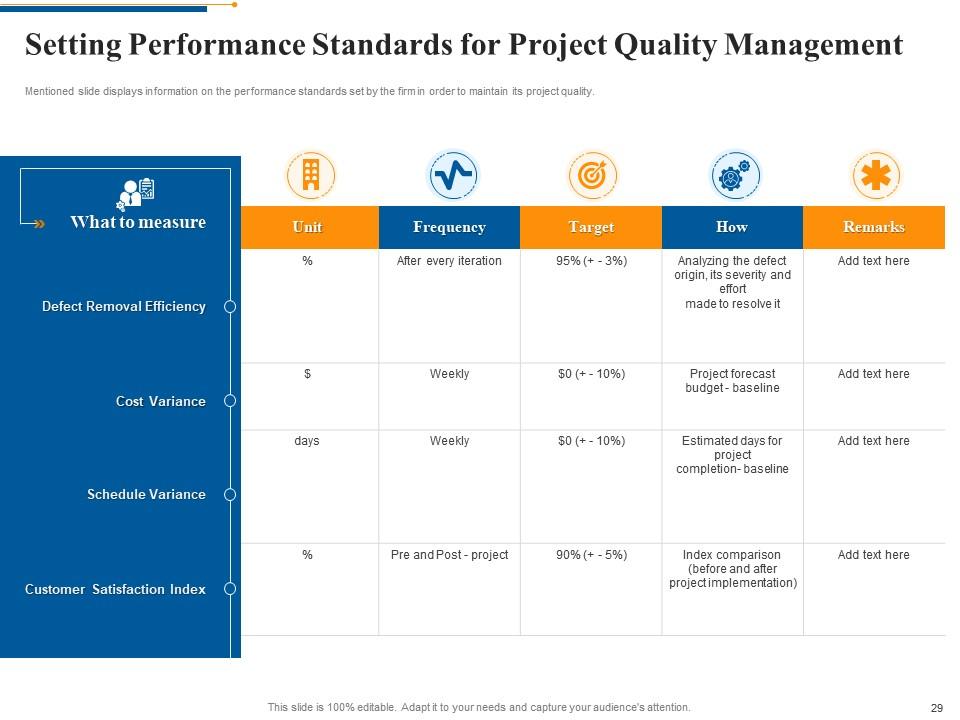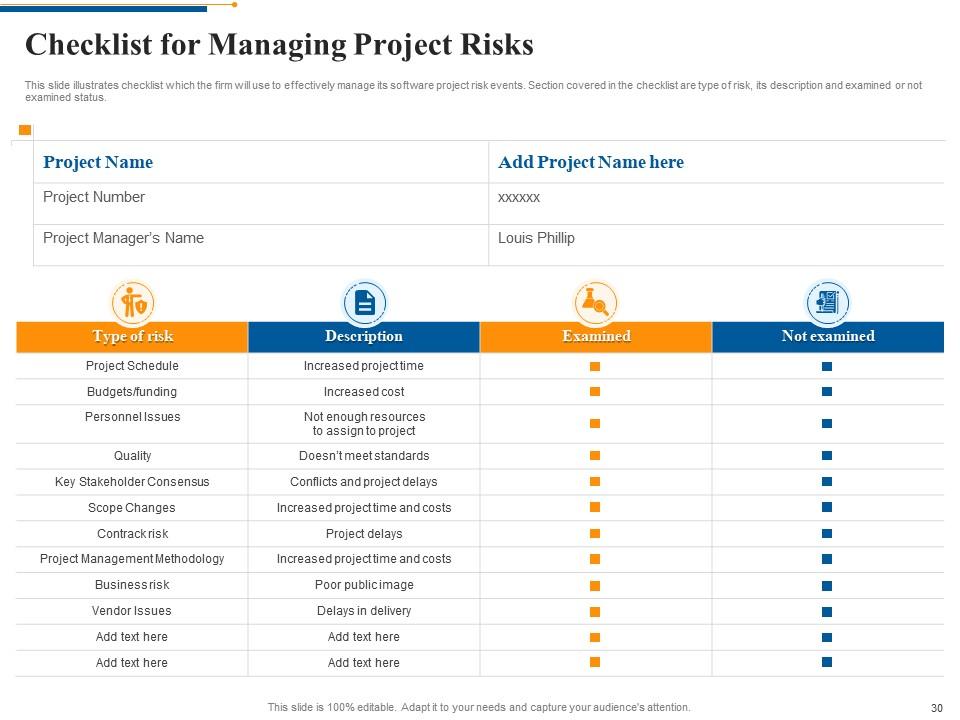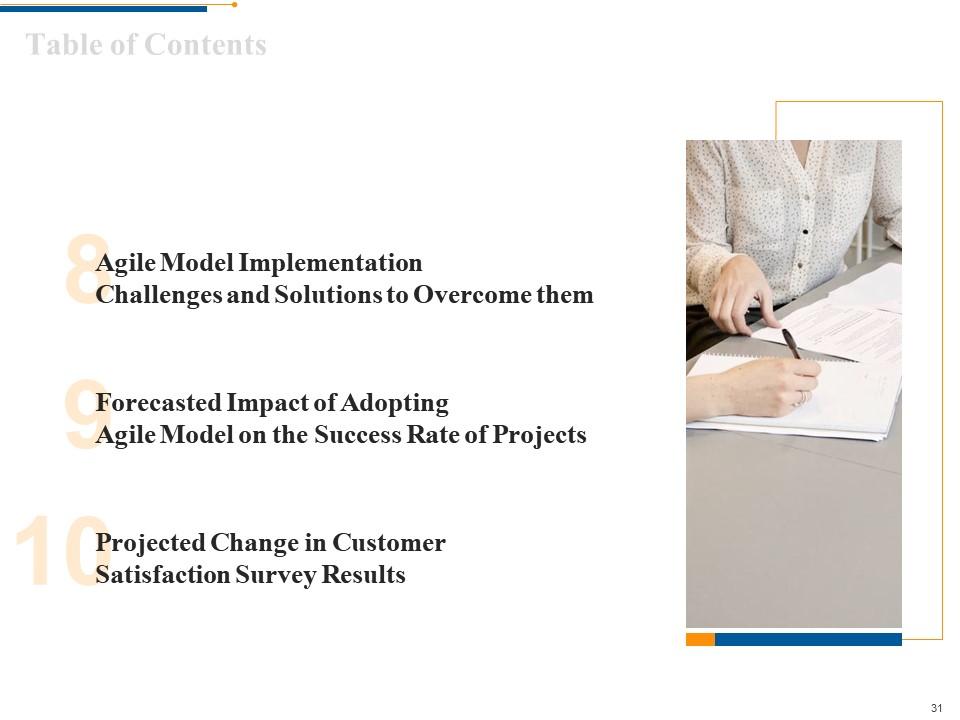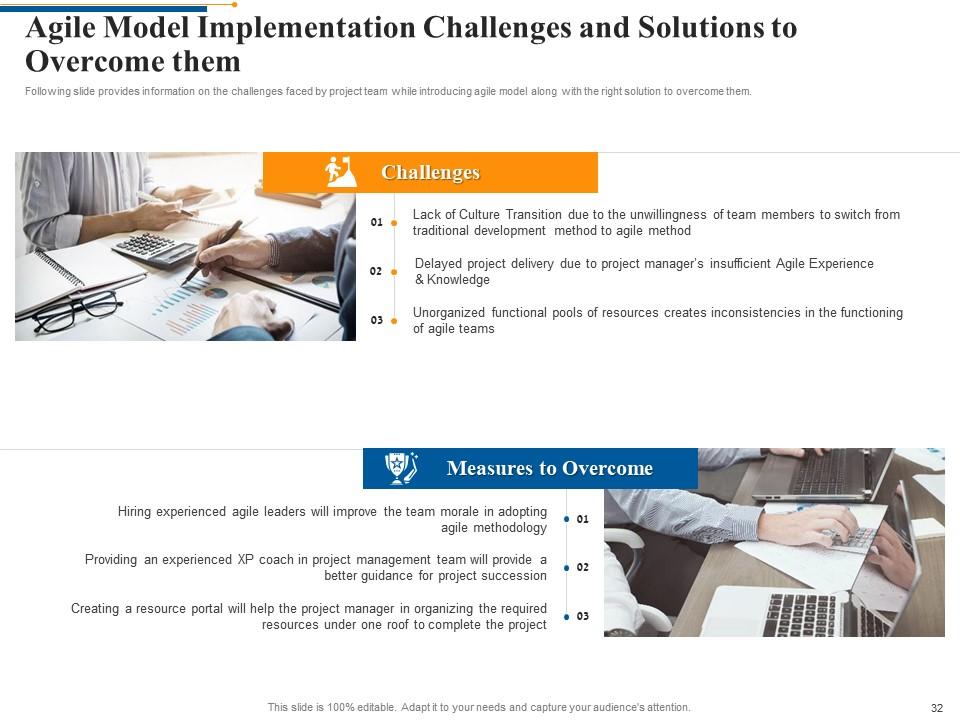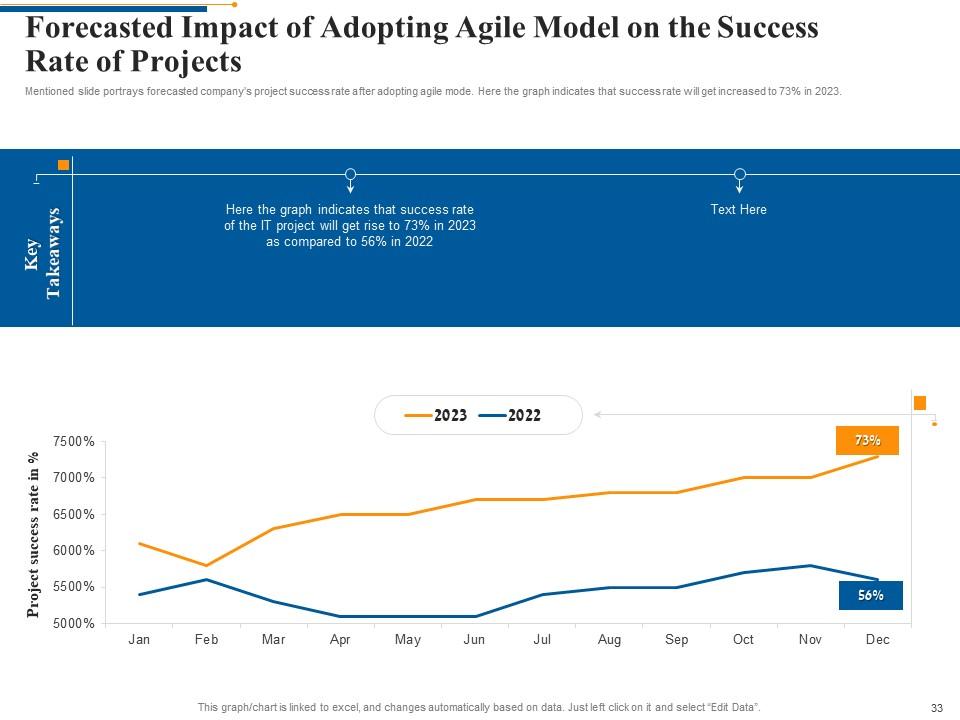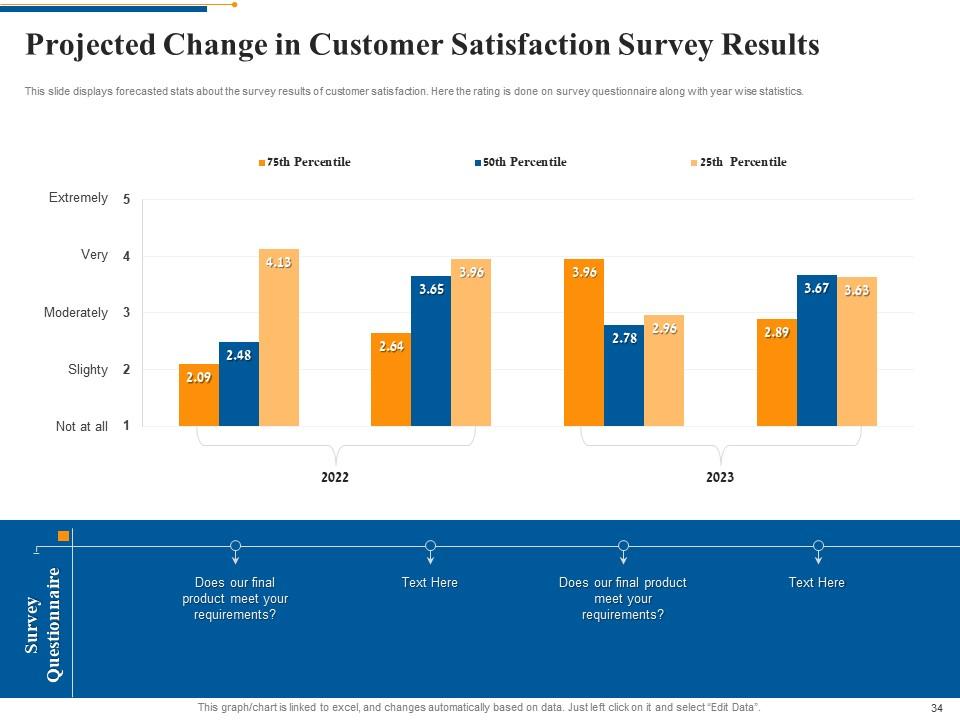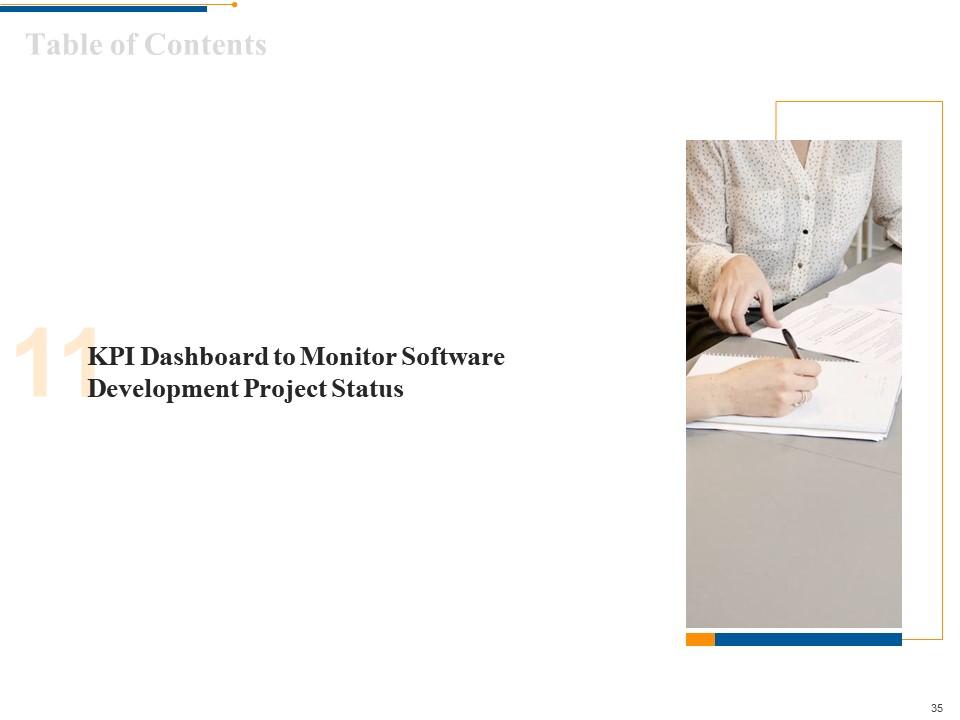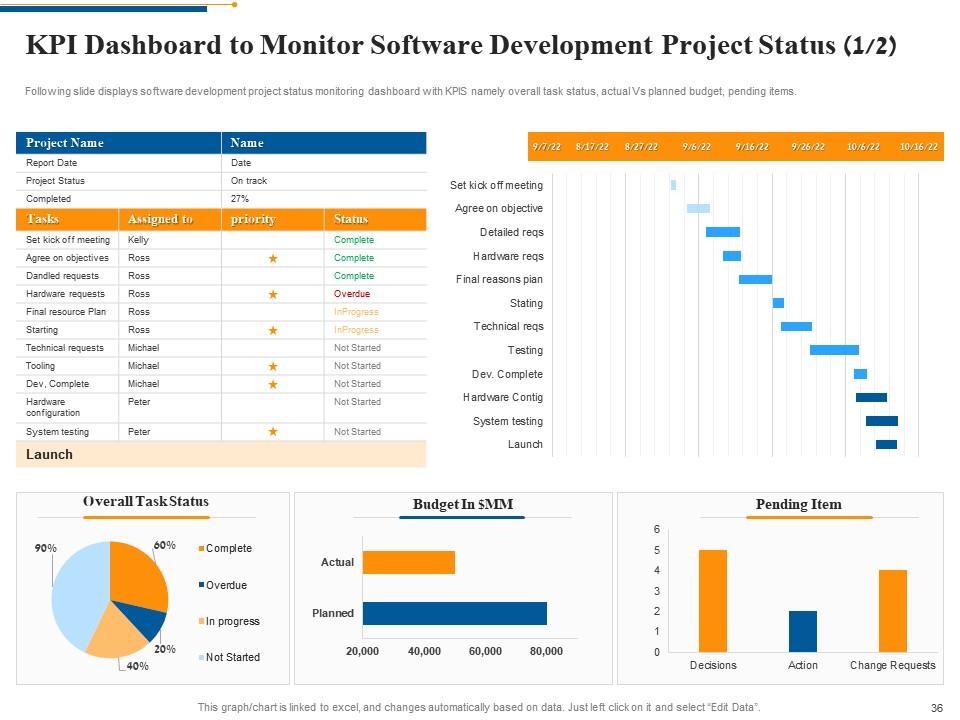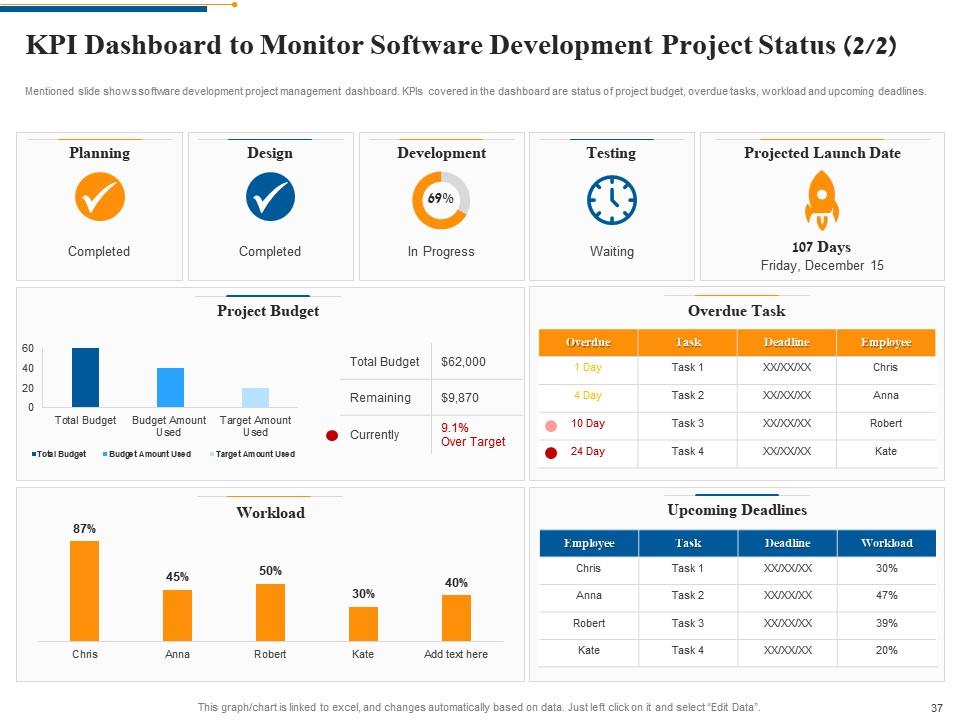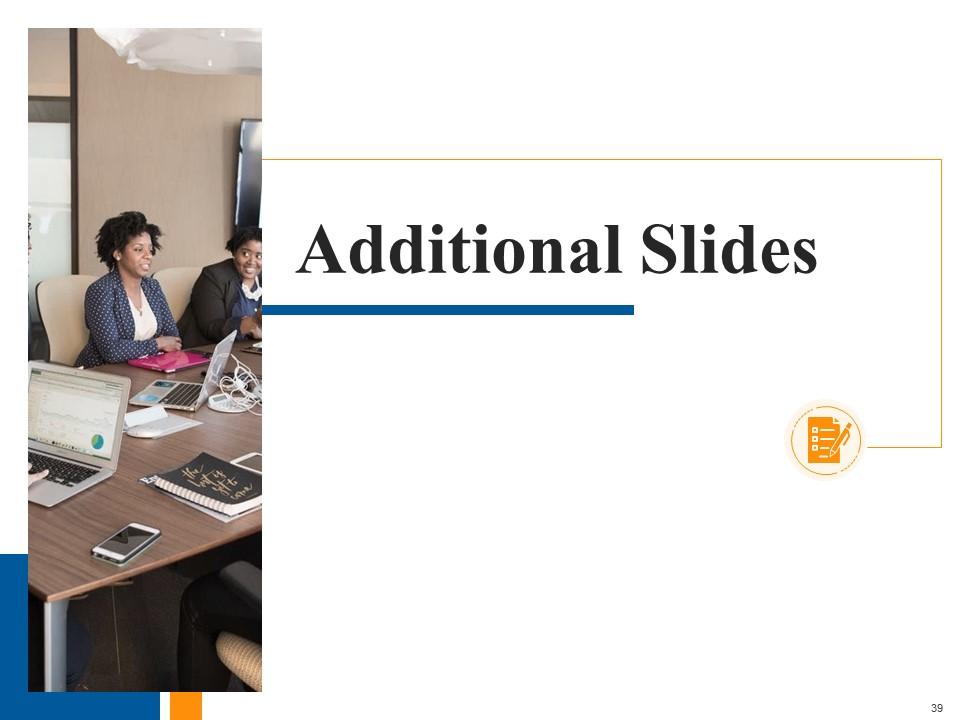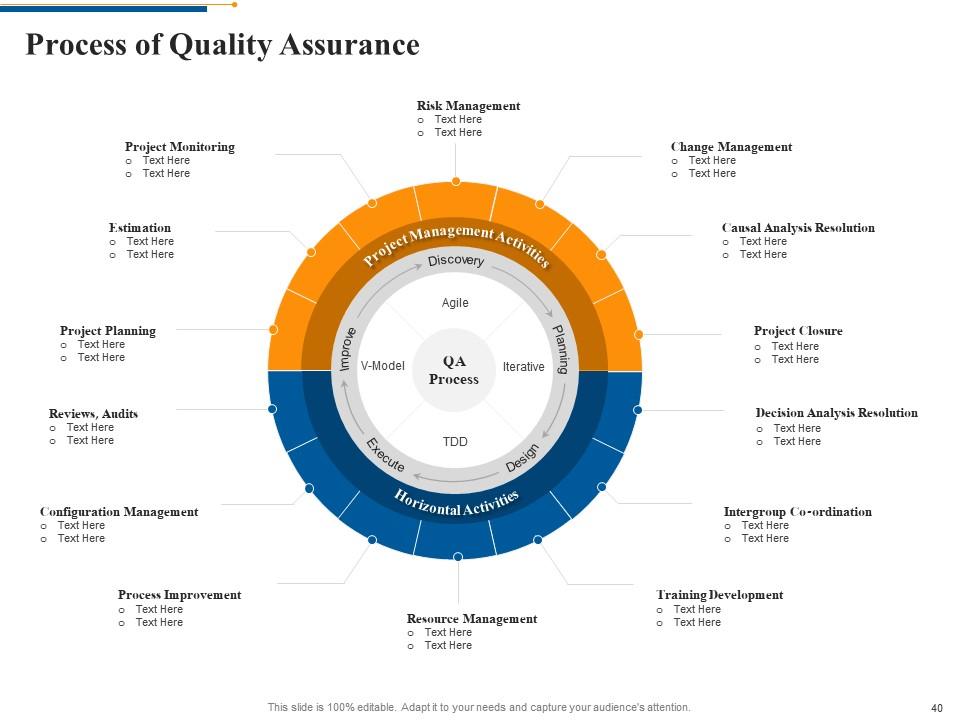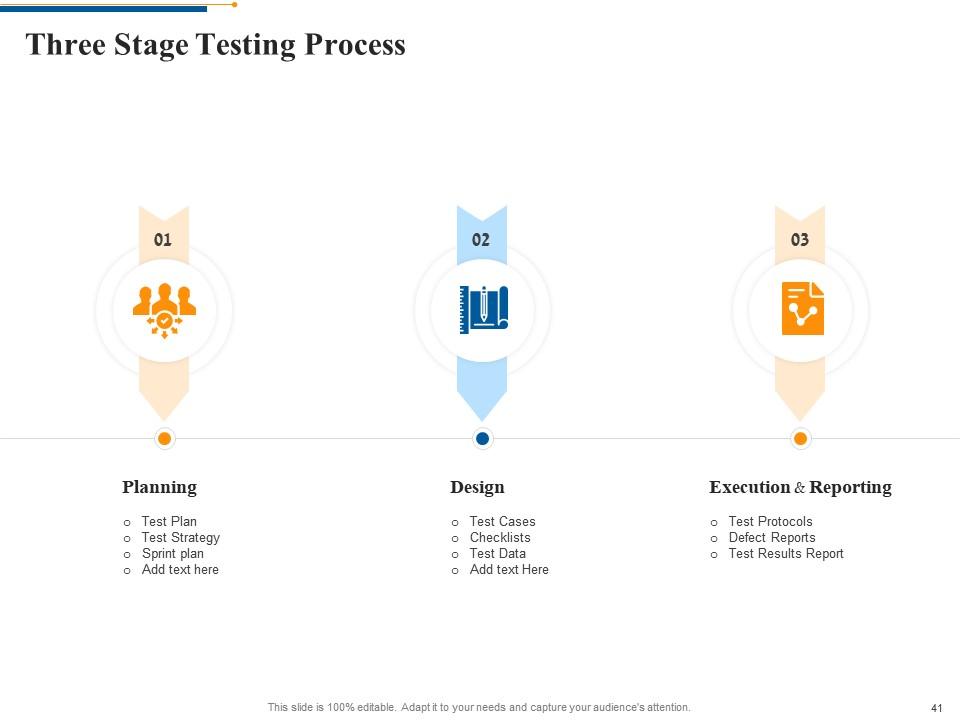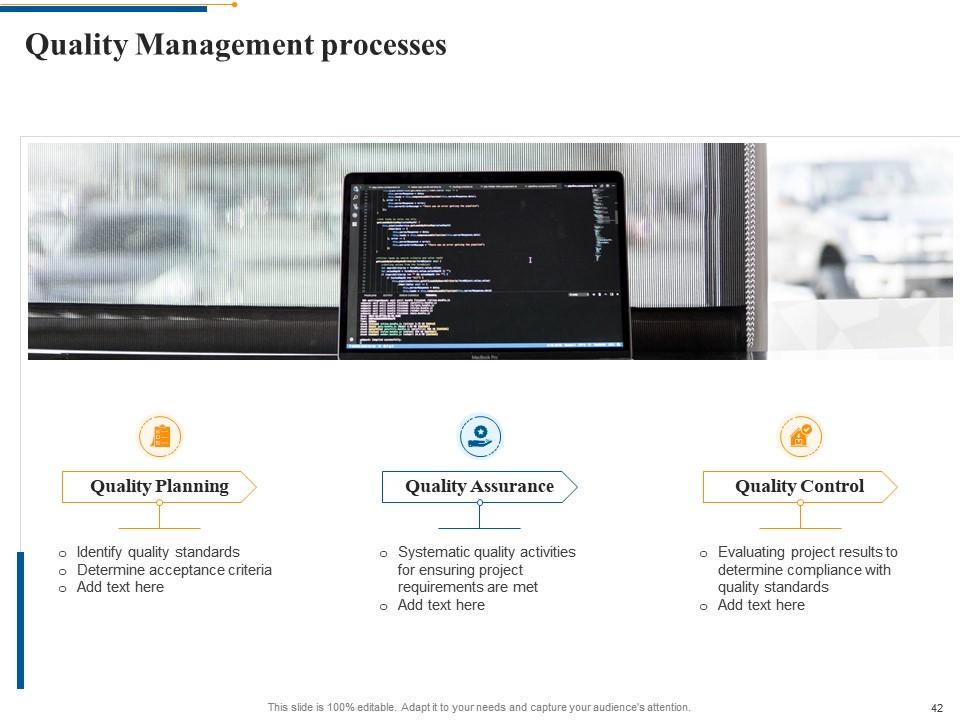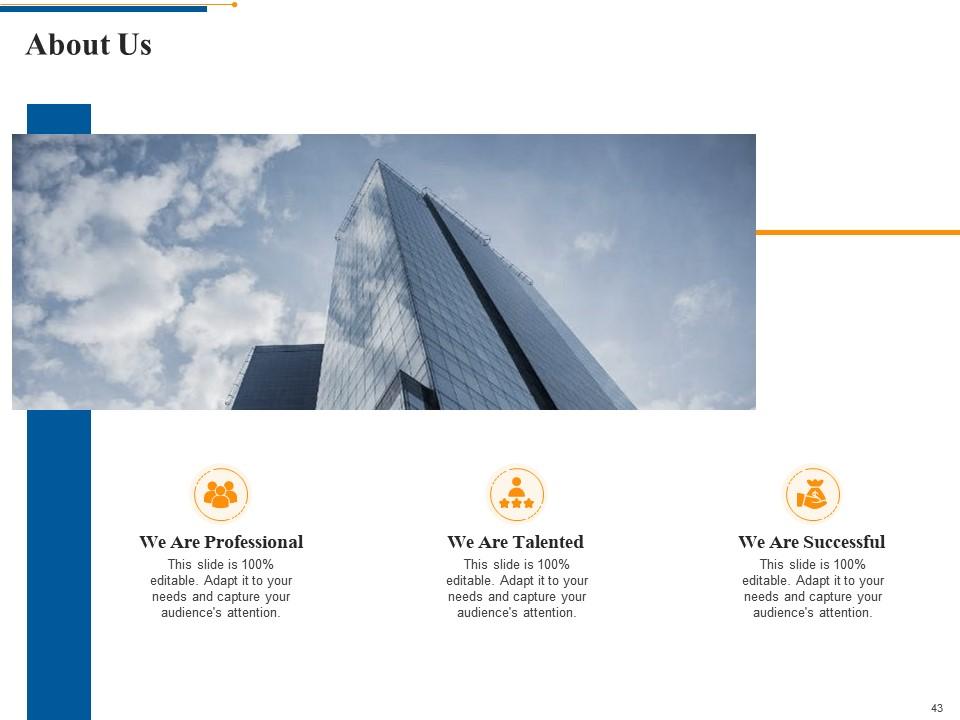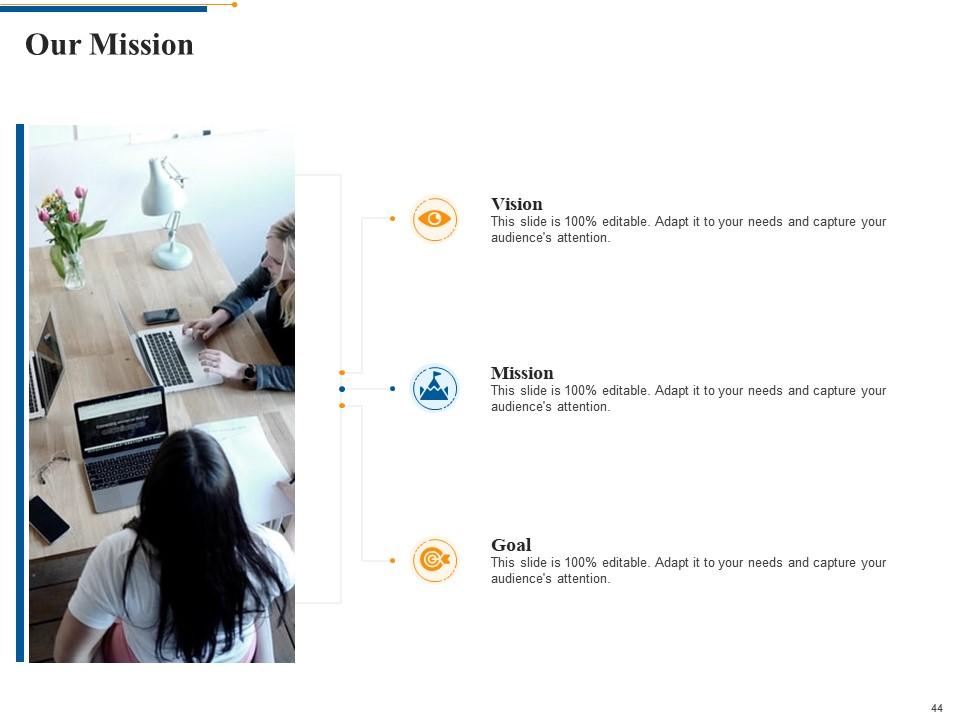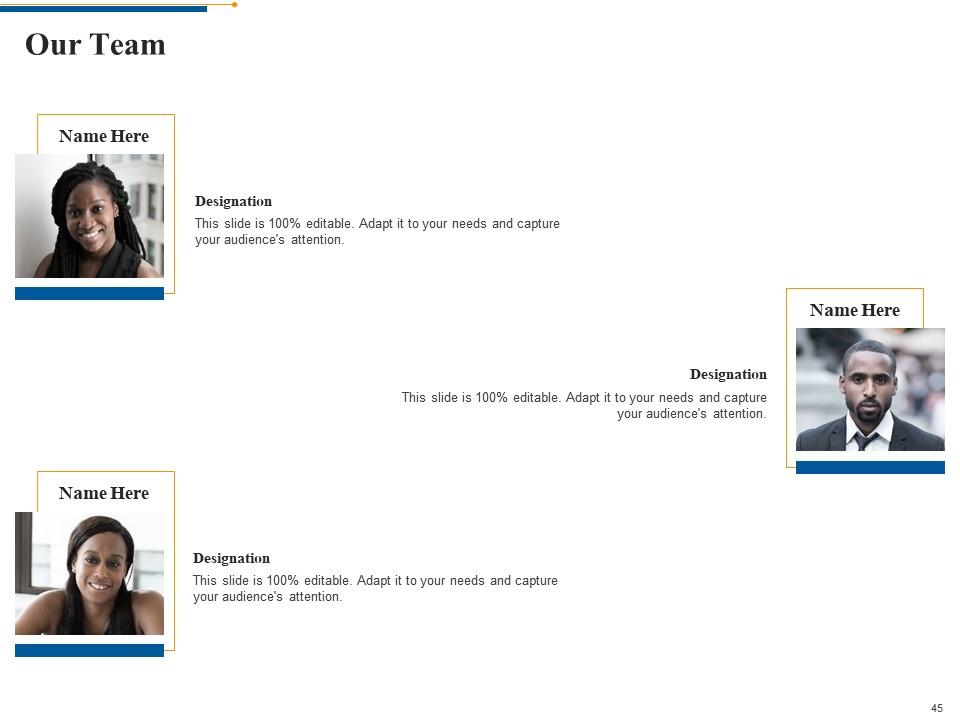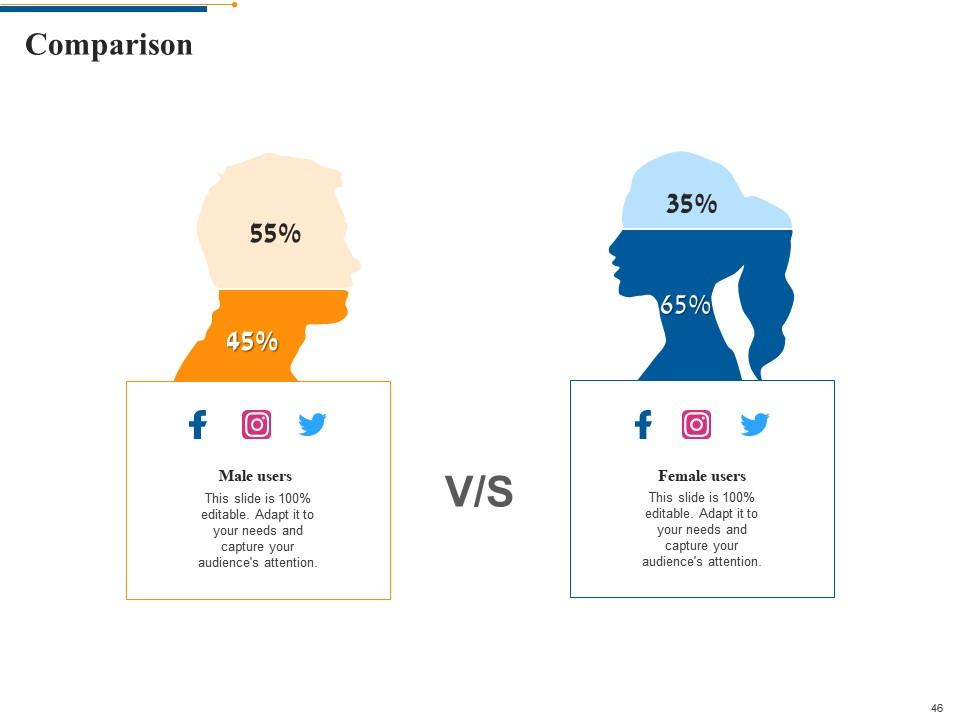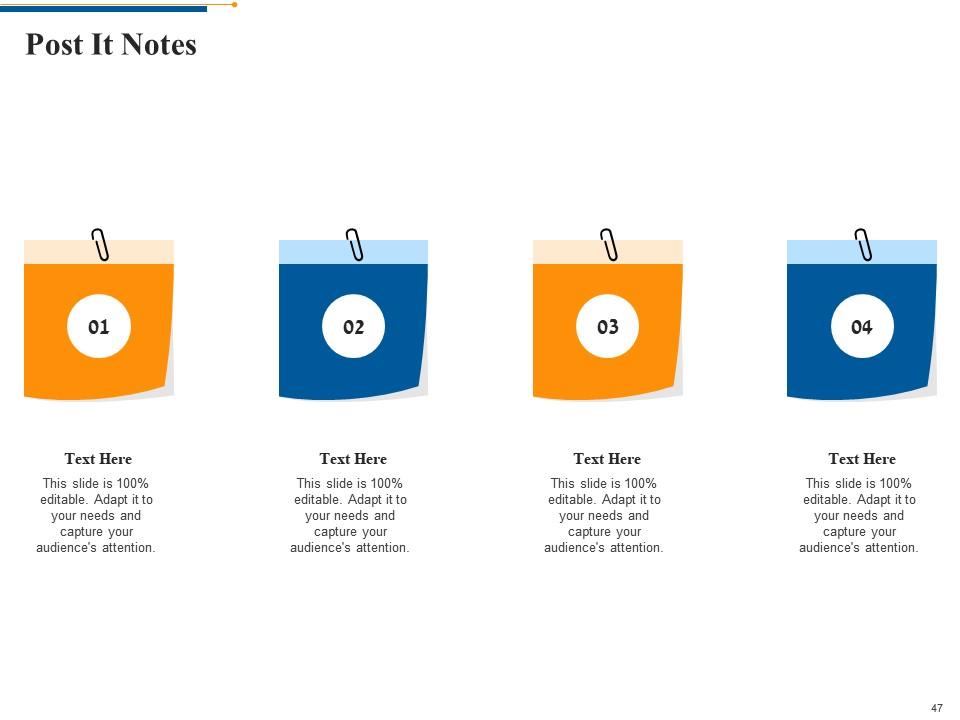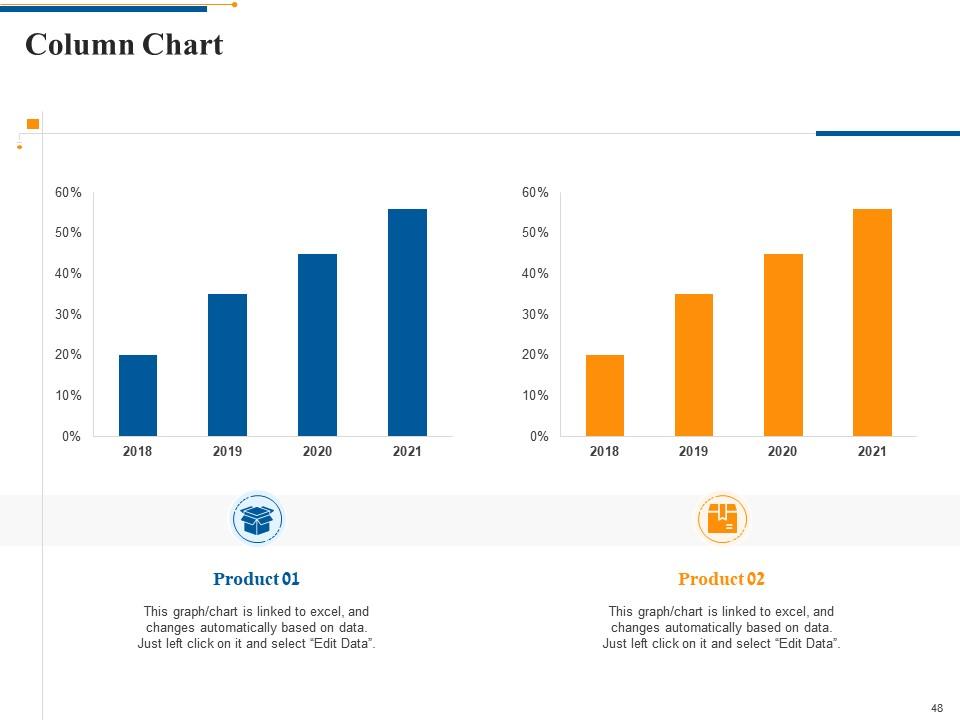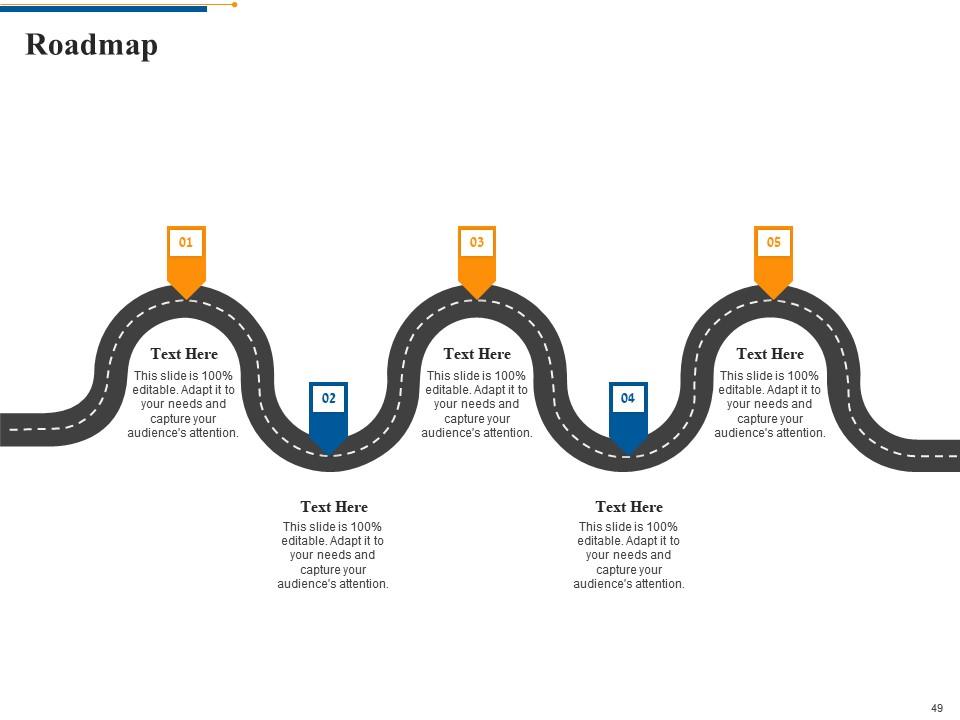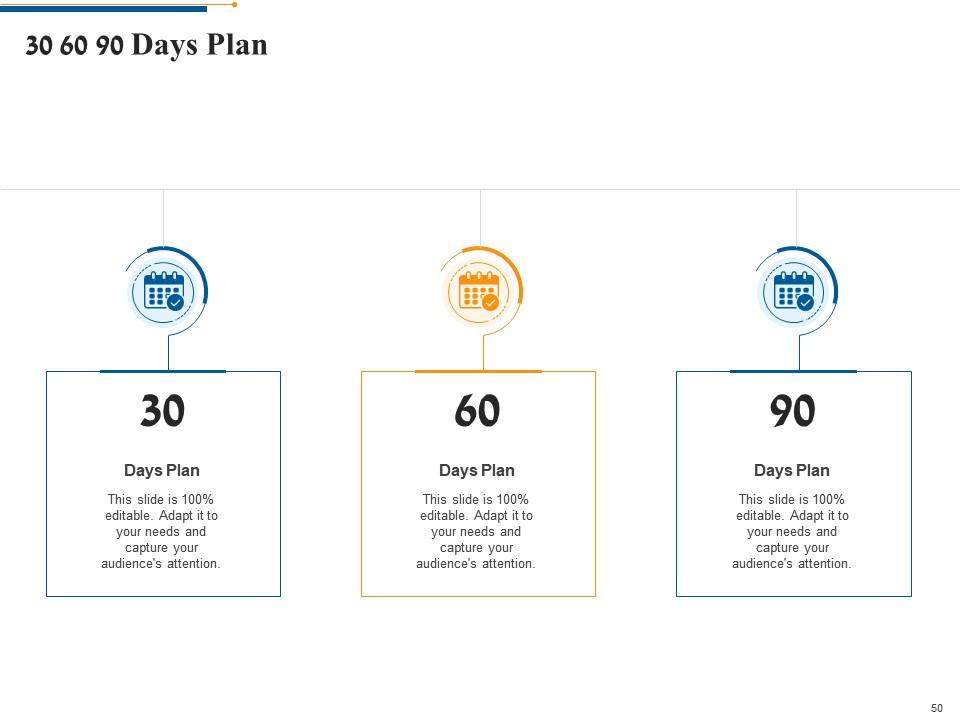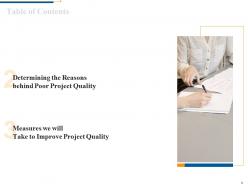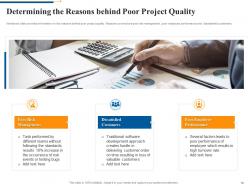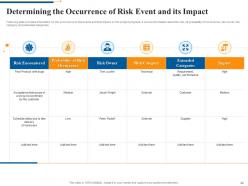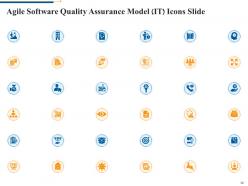Agile software quality assurance model it powerpoint presentation slides
Presenting Agile software quality assurance model to let you make data driven decisions without any hassle. Quality assurance QA is a critical component of the software development process that ensures product and service excellence. Organizations are implementing various models to assist software development teams in producing high quality software. This presentation will be useful for businesses that want to shift from a traditional software development approach to the agile methodology to improve project quality. Our presentation begins with the section. analyzing the current performance of software development projects. companies can use this section to address information about the current software development model, project success rate, and customer satisfaction details. Businesses can determine the reasons behind poor project quality and measures we will take to improve project quality slides to address major performance issues and solutions to overcome them. Introducing the agile model for the project quality assurance section will help the companies provide in-depth information about their focus areas, best fit, agile model, framework, and software development lifecycle to ensure project quality. Effective resource and risk event management is required to ensure project quality. Companies can use the sections titled effectively managing risk events and ensuring project quality by effectively managing risk events to meet the desired objectives. To ensure the effectiveness of any new methodology or process change, a set of standards must be implemented. Companies can use section effectively managing project quality post agile model implementation to ensure the quality standards soon. Agile model implementation challenges and solutions to overcome them slide will assist businesses in addressing implementation bottlenecks and ways to successfully resolve them. The slides, specifically the forecasted impact of adopting an agile model on project success rates and the projected change in customer satisfaction survey results, will assist companies in determining the success of introducing an agile approach over a traditional one. Lastly, the KPI dashboard section will assist the companies in effectively monitoring the status of their software development project status. Get access to this amazing agile software quality assurance model PowerPoint template to adapt to the changes smoothly.
Presenting Agile software quality assurance model to let you make data driven decisions without any hassle. Quality assuran..
- Google Slides is a new FREE Presentation software from Google.
- All our content is 100% compatible with Google Slides.
- Just download our designs, and upload them to Google Slides and they will work automatically.
- Amaze your audience with SlideTeam and Google Slides.
-
Want Changes to This PPT Slide? Check out our Presentation Design Services
- WideScreen Aspect ratio is becoming a very popular format. When you download this product, the downloaded ZIP will contain this product in both standard and widescreen format.
-

- Some older products that we have may only be in standard format, but they can easily be converted to widescreen.
- To do this, please open the SlideTeam product in Powerpoint, and go to
- Design ( On the top bar) -> Page Setup -> and select "On-screen Show (16:9)” in the drop down for "Slides Sized for".
- The slide or theme will change to widescreen, and all graphics will adjust automatically. You can similarly convert our content to any other desired screen aspect ratio.
Compatible With Google Slides

Get This In WideScreen
You must be logged in to download this presentation.
PowerPoint presentation slides
Deliver this complete deck to your team members and other collaborators. Encompassed with stylized slides presenting various concepts, this Agile Software Quality Assurance Model IT Powerpoint Presentation Slides is the best tool you can utilize. Personalize its content and graphics to make it unique and thought provoking. All the fifty one slides are editable and modifiable, so feel free to adjust them to your business setting. The font, color, and other components also come in an editable format making this PPT design the best choice for your next presentation. So, download now.
People who downloaded this PowerPoint presentation also viewed the following :
Content of this Powerpoint Presentation
Slide 1: This is the cover slide for Agile Software Quality Assurance Model PowerPoint Deck
Slide 2: This slide showcases the Agenda for Software Agile Quality Assurance Model
Slide 3: This is a Table of Contents slide that lists out the elements covered in the deck
Slide 4: This slide introduces the current performance of software development projects.
Slide 5: This slide displays waterfall approach currently used by the project management team for effectively managing software development projects. It also shows the activities covered by each stage of the model starting from analysis to operation and maintenance.
Slide 6: This slide portrays company’s project success rate undertaken and covered over the last two years. Here the graph indicates that success rate gets declined to 56% in 2022.
Slide 7: This slide displays survey results of customer satisfaction. Here the rating is done on survey questionnaire along with year wise statistics.
Slide 8: This slide provides information on the impact of quality attributes namely availability, flexibility, testability and scalability on software development life cycle phases.
Slide 9: This slide provides information on the reasons behind poor project quality and the measures to be taken to improve the project quality.
Slide 10: This slide provides information on the reasons behind poor quality project. Reasons covered are poor risk management, poor employee performance and dissatisfied customers.
Slide 11: This slide shows information about the right solutions to overcome project quality challenges. Solutions covered are adopting agile model and introducing quality risk management process.
Slide 12: This slide introduces Agile model for project quality assurance.
Slide 13: This slide provides information on the areas on which the firm will focus in order to improve its project quality. Areas covered are people and culture, core process, test prioritization.
Slide 14: This slide provides information on different agile models. Here the comparison is based on parameters namely goal workflow approach, coding standards, testing approach and design complexity.
Slide 15: This slide illustrates the process of extreme programming that will be adopted by the firm in order to ensure its project quality.
Slide 16: This slide displays the software development lifecycle along with the details of software assurance and agile development process.
Slide 17: This slide introduces the ways to effectively manage hte resource pool.
Slide 18: This slide shows the information about resources required to complete the software development project along with the details of total working hours by month.
Slide 19: This slide displays assessment form that firm will use to determine its employee performance based on the ratings scored.
Slide 20: This slide provides information on the factors behind poor employee performance. Factors covered are lack of agile knowledge, no work life balance and bad company culture.
Slide 21: This slide portrays information about the measures firm will take in order counter the factors behind poor performance and to improve its employees performance.
Slide 22: This slide introduces the ways to effectively manage the project quality post agile model implementation.
Slide 23: This slide portrays quality risk management process that firm will use in order maintain and ensure its project quality.
Slide 24: This slide provides information on the occurrence of risk events and their impact on the project progress. It covers information about the risk, its probability of occurrence, risk owner, risk category and extended categories.
Slide 25: This slide displays risk assessment form covering information about project name, its reference document, project manager name, risk input, causes, assessment ratings and justification.
Slide 26: This slide shows mitigation plan for resolving encountered threat. It includes information about encountered risk, its mitigation plan, responsible person, expected resolution time and communication mode.
Slide 27: This slide introduces the ways to effectively managing project quality post agile model implementation.
Slide 28: This slide provides information on how the firm will maintain the quality of its software development projects after adopting the agile model.
Slide 29: This slide displays information on the performance standards set by the firm in order to maintain its project quality.
Slide 30: This slide illustrates checklist which the firm will use to effectively manage its software project risk events. Section covered in the checklist are type of risk, its description and examined or not examined status.
Slide 31: This slide introduces agile model implementation challenges and solutions.
Slide 32: This slide provides information on the challenges faced by project team while introducing agile model along with the right solution to overcome them.
Slide 33: This slide portrays forecasted company’s project success rate after adopting agile mode. Here the graph indicates that success rate will get increased to 73% in 2023.
Slide 34: This slide displays forecasted stats about the survey results of customer satisfaction. Here the rating is done on survey questionnaire along with year wise statistics.
Slide 35: This slide presents KPI Dashboard to Monitor Software Development Project Status
Slide 36: This slide displays software development project status monitoring dashboard with KPIS namely overall task status, actual Vs planned budget, pending items.
Slide 37: This slide shows software development project management dashboard. KPIs covered in the dashboard are status of project budget, overdue tasks, workload and upcoming deadlines.
Slide 38: This is an icon slide. Use it as per your needs.
Slide 39: This is an Additional Slide
Slide 40: This slide showcases Process of Quality Assurance
Slide 41: This slide presents Three Stage Testing Process
Slide 42: This slide presents the Quality Management processes
Slide 43: This is the About us slide which can be used to give a brief overview of your company.
Slide 44: This is Our Mission Our Vision slide to state your mission, vision etc.
Slide 45: This is Our Team slide with name and designation to fill.
Slide 46: This is a Comparison slide to make comparison between two elements.
Slide 47: This is a Post It Notes slides that can be used to keep the important data at one place.
Slide 48: This is a Column Chart slide that can be used to conduct a comparative analysis of two different products.
Slide 49: This is a Roadmap slide that can be used to present series of events.
Slide 50: This is a 30 60 90 Days Plan slide that can be used to formulate robust plans.
Slide 51: This is a Thankyou slide for acknowledgment. You can share your contact details here.
Agile software quality assurance model it powerpoint presentation slides with all 51 slides:
Use our Agile Software Quality Assurance Model IT Powerpoint Presentation Slides to effectively help you save your valuable time. They are readymade to fit into any presentation structure.
-
Use of different colors is good. It's simple and attractive.
-
Appreciate the research and its presentable format.
-
The Designed Graphic are very professional and classic.
-
Perfect template with attractive color combination.



